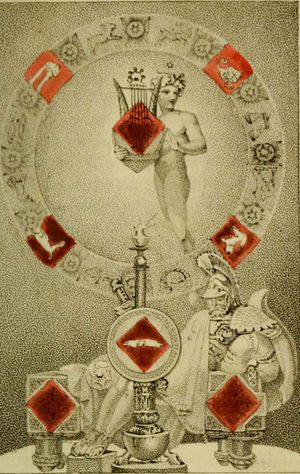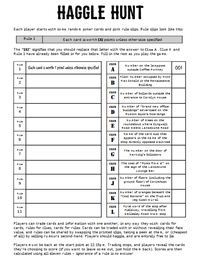Haggle Hunt
| Haggle Hunt | |
|---|---|

| |
| Designer: | Kevan Davis, based on Sid Sackson's Haggle |
| Year: | 2016 |
| Players: | 4-11 |
| Stuff required: | Playing cards; printed slips; scoring sheets; envelopes |
| Crew required: | One |
| Preparation: | Advance recon of the playing area, printing slips and stuffing envelopes |
| Time required: | Half an hour upwards |
| Place required: | A large outdoor area |
| Activities: | Finding, trading |
| This is a playable game - it's finished, tested and ready to play. | |
| This game is made available under an Attribution-Noncommercial Creative Commons licence. (What does this mean?) | |
Swapping poker cards according to the hidden rules of the city.
This game is based on Sid Sackson's 1960s game Haggle, which uses coloured pieces of paper and secret rules to be traded casually in the background of a party setting over the course of a full evening. This variant requires that the players perform a scavenger hunt around a wider area before they can fully understand each rule, forcing them to balance hunting time against negotiation, and allowing the game to be played in a much shorter time while still splitting people up and having them encounter each other by chance.
Setting up
The game needs some preparation in advance based around the area you're going to be playing it in. Once you've chosen a site, walk around it looking for low numbers and card-related words in the environment, and make a note of what you find. (Running the game in Croydon a few years ago, these included things like "Number on the lamppost outside Coffee Monkey", "Number of oranges on the fruit stall artwork" and "Card suit that appears in the name of the shop directly opposite Waitrose".) You'll need eleven of these.
Keep in mind that some players might try to solve the clues using Google Street View on their phones - it rewards lateral thinking if a few clues are solveable that way, but make sure that most of them require a player to actually walk somewhere.
Make a scoring sheet that looks like this:
- Example scoring sheet
It starts and ends with the player instructions text in the next section of this page, and has two tables - one for 11 rules, and one for the 11 clues you made in the previous step, which are now given letters A through L. Fill in the answers for Rule 1 and Clue A to give players an example of how the game works, and leave the rest empty. Put a map on the back so that players know the area they'll be exploring to look for the clues (and where they'll be able to find other players).
Prepare 20 rule slips, each one containing one rule from Rules 2 through 11, and each rule appearing on two slips. (Rules are described in a later section.) Prepare and print one scoring sheet per player. Take a regular deck of poker cards, and add or remove jokers according to the number of players in the table below.
Prepare an envelope for each player containing a number of random cards and rule slips, according to the following table (eg. in a six player game, two of the players each receive an envelope with 9 cards and 4 rule slips; the other four each receive an envelope with 9 cards and 3 slips).
Although make sure that no envelope contains the same rule twice - either deal them from an ordered pile as you fill the envelopes, or lay them all out on a table while you're assigning them.
| Players | Cards | Rule slips |
|---|---|---|
| 4 | 14 | 5/5/5/5 |
| 5 | 11 (-1 Joker) | 4/4/4/4/4 |
| 6 | 9 (no Jokers) | 3/3/3/3/4/4 |
| 7 | 8 | 2/3/3/3/3/3/3 |
| 8 | 7 | 2/2/2/2/3/3/3/3 |
| 9 | 6 (no Jokers) | 3/3/2/2/2/2/2/2/2 |
| 10 | 5 (-1 Joker) (also make up a spare hand*) | 2 each |
| 11 | 5 (-1 Joker) | 1/1/2/2/2/2/2/2/2/2/2 |
* With ten players, the moderator keeps a spare hand of five cards and will trade one random card at a time with anyone who wants to, throughout the game – just not with the same player twice in a row.
Player instructions
Each player starts with some random poker cards and some rule slips. Rule slips look like this:
| Rule 1: Each card is worth [A] points unless otherwise specified |
The “[A]” signifies that you should replace that letter with the answer to Clue A. Clue A and Rule 1 have already been filled in for you. Fill in the rest as you play the game.
Players can trade cards and information with one another, in any way they wish: cards for cards, rules for clues, cards for rules. Cards can be traded with or without revealing their face value, and rules can be shared by swapping the printed slips, taking a peek at them, or (cheapest of all) by selling rumours second-hand. Players should haggle, and are entirely free to lie.
Players must be back at the start point at [whatever end time]. Trading stops, and players reveal the cards they're choosing to score (if you want to leave some out, just hold them back). Scores are then calculated using all eleven rules – ignorance of a rule is no excuse!
The game is entirely confined to the pale rectangle on the map - you can find all of the clues by walking around its perimeter. X marks the spot where the game starts and ends, and the game moderator will spend the duration of the game there, if you have any questions.
Gameplay
At any starting location, hand out envelopes at random and explain the game. The game begins, and players have to decide whether to run off and gather clues (which are a valuable trading resource at the start of the game) or trade information and cards between themselves.
When the time is up, the moderator scores each set of cards they have received - they'll probably want to step aside and total each set, before returning to the group to announce winners.
If any players are late back, they score nothing.
Rule slips
Each rule slip has a single rule for how the cards are scored, and is numbered. Most of the rules include one clue letter: the player has to find out what that clue corresponds to, to fully understand the rule. Clue letters can be repeated between clues.
Rule 1 is printed on the players' handouts as a free example rule; Rules 2 through 11 are printed on slips.
The rules used in this game's first run were:
- Rule 1: Each card is worth 1 point unless otherwise specified
- Rule 2: If a hand contains all four suits, it scores a bonus [G] points
- Rule 3: If a hand has exactly one [L], it scores a bonus [H] points
- Rule 4: The Joker is worth no points
- Rule 5: The [B] of spades is worth [D] points
- Rule 6: Cards of suit [F] are worth [E] points each
- Rule 7: If you have more than [K] black cards, all your black cards must be removed before scoring
- Rule 8: Cards of rank [D] are worth 2 points each
- Rule 9: Three or more cards of the same rank scores a bonus [D] points
- Rule 10: If any of a player's cards have a rank below [C] they lose 2 points (aces are low, counting as 1s)
- Rule 11: If a player has more than [J] cards, they cannot win
Scoring tip
It can save a lot of time to write out a simple list of steps to go through for scoring - it also makes sure that you'll apply the rules consistently. The steps I used for the example rules above were:
- Are there more than 3 black cards? If so, remove all black cards.
- Are there more than 10 cards? Player is eliminated.
- Score 1 point per card.
- Do they have all four suits? +4 points
- Do they have only a single King? +3 points
- Do they have any Jokers? -1 point per Joker
- Do they have the 4 of Spades? +4 points
- Do they have any hearts or 5s? +1 point per card (5 of Hearts is still just +1)
- Do they have three (or more) of a kind? +5 points
- Do they have any aces, 2s or 3s? -2 points
Play history
Haggle Hunt ran as part of Croydon Fun Weekend 2016.
